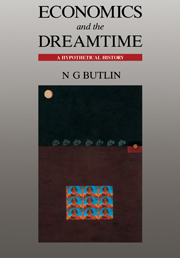Book contents
- Frontmatter
- Contents
- Preface
- Acknowledgements
- Figures
- Maps
- Tables
- Introduction
- Part I The palaeoeconomic history of Aboriginal migration
- 1 Introduction
- 2 Conventional views and alternative approaches
- 3 Non-Malthusian issues: pathways and innovations
- 4 Scarcity possibilities in Aboriginal migration
- 5 Some possible migration scenarios
- 6 A synthesis
- Part II Development, structure and function of Aboriginal economy
- Part III Disease, economics and demography
- Part IV The establishment of a bridgehead economy: 1788–1810
- Part V The takeover process: 1788–1850
- Bibliography
- Appendix 1 Preliminary model/checklist of Aboriginal migration to Australia
- Appendix 2 NOAA depth contour maps
- Index
2 - Conventional views and alternative approaches
Published online by Cambridge University Press: 06 July 2010
- Frontmatter
- Contents
- Preface
- Acknowledgements
- Figures
- Maps
- Tables
- Introduction
- Part I The palaeoeconomic history of Aboriginal migration
- 1 Introduction
- 2 Conventional views and alternative approaches
- 3 Non-Malthusian issues: pathways and innovations
- 4 Scarcity possibilities in Aboriginal migration
- 5 Some possible migration scenarios
- 6 A synthesis
- Part II Development, structure and function of Aboriginal economy
- Part III Disease, economics and demography
- Part IV The establishment of a bridgehead economy: 1788–1810
- Part V The takeover process: 1788–1850
- Bibliography
- Appendix 1 Preliminary model/checklist of Aboriginal migration to Australia
- Appendix 2 NOAA depth contour maps
- Index
Summary
Prehistorians' views on Aboriginal migration
Given their reliance on empirical evidence, prehistorians have generally — but not always — been cautious in their statements about Aboriginal migration. The few comments here do not do justice to differences of opinion between some individuals but very briefly indicate what appears to be a prevailing view. It is agreed that Aborigines arrived by sea; their ancestors passed out of South-east Asia through the islands; and the ultimate immigrants arrived not less than 40000 years ago. Since New Guinea was joined physically to Australia for about 100000 years before around 8000 BP, the most common belief now seems to be a first arrival in New Guinea and then land passage to the present Australian mainland (e.g. Jones, 1977; Mulvaney and White, 1987; Walker, 1972; White and O'Connell, 1982).
In exploring migration to New Guinea/Australia, given a lack of interest in economics, most attention has been paid to pathways across the islands (Allen et al., 1977); the question of means has dominated over those of motive and opportunity. Indeed, insofar as opportunity has entered the debate, prehistorians' observations on ice age conditions and consequent lowering of seas (which reduced the length and frequency of sea trips) have sometimes appeared contrary to present understanding. Any likely economic motivation has generally been submerged under an essentially non-Malthusian and culture-driven view of the world of hunter gatherers (Birdsell, 1972; Hassan, 1981).
- Type
- Chapter
- Information
- Economics and the DreamtimeA Hypothetical History, pp. 11 - 13Publisher: Cambridge University PressPrint publication year: 1993



